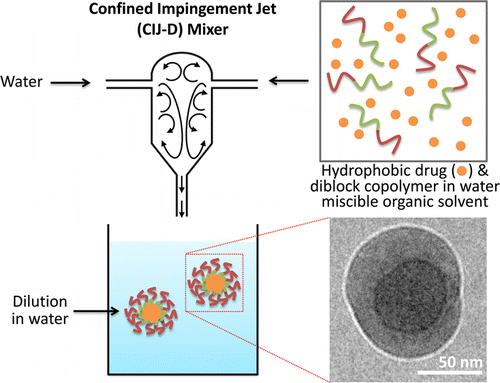Pustulka, K. M.; Wohl, A. R.; Lee, H. S.; Michel, A. R.; Han, J.; Hoye, T. R.; McCormick, A. V.; Panyam, J.; Macosko, C. W. Mol. Pharmaceutics 2013, 10, 4367–4377.
Flash nanoprecipitation (FNP) is a process that, through rapid mixing, stabilizes an insoluble low molecular weight compound in a nanosized, polymer-stabilized delivery vehicle. The polymeric components are typically amphiphilic diblock copolymers (BCPs). In order to fully exploit the potential of FNP, factors affecting particle structure, size, and stability must be understood. Here we show that polymer type, hydrophobicity and crystallinity of the small molecule, and small molecule loading levels all affect particle size and stability. Of the four block copolymers (BCP) that we have studied here, poly(ethylene glycol)-b-poly(lactic-co-glycolic acid) (PEG-b-PLGA) was most suitable for potential drug delivery applications due to its ability to give rise to stable nanoparticles, its biocompatibility, and its degradability. We found little difference in particle size when using PLGA block sizes over the range of 5 to 15 kDa. The choice of hydrophobic small molecule was important, as molecules with a calculated water–octanol partition coefficient (clogP) below 6 gave rise to particles that were unstable and underwent rapid Ostwald ripening. Studies probing the internal structure of nanoparticles were also performed. Analysis of differential scanning calorimetry (DSC), cryogenic transmission electron microscopy (cryo-TEM), and 1H NMR experiments support a three-layer core–shell–corona nanoparticle structure.
